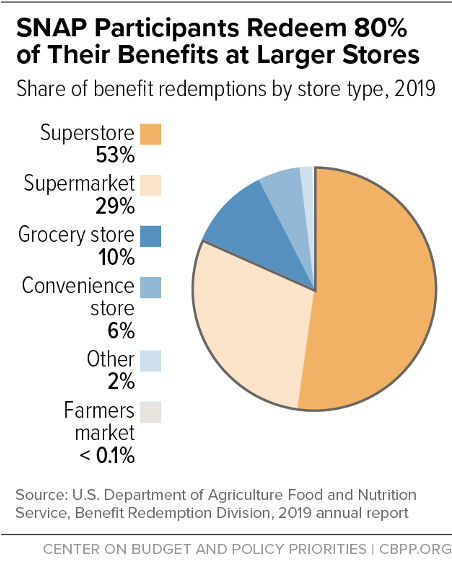- Home
- SNAP Retailers Database
SNAP Retailers Database
The Supplemental Nutrition Assistance Program (SNAP) helps families and individuals afford a basic diet by providing modest benefits that are used to purchase food in stores throughout the nation. SNAP is extremely efficient; by boosting low-income households’ food purchasing power so they can buy needed food directly from stores, SNAP integrates economically marginalized persons with almost no administrative overhead.
With about 248,000 retailers participating in SNAP nationwide, the program represents an important public-private partnership. These stores, ranging from big-box superstores and supermarkets to specialty stores, farmers markets, and convenience stores, redeemed a total of about $55.6 billion in benefits in fiscal year 2019. While the majority of stores fall into the convenience and grocery store categories, most participants shop at superstores and supermarkets. Over 80 percent of benefits are redeemed at these larger stores.
Retailers must apply to participate and meet certain standards prescribed under federal law. USDA’s Food and Nutrition Service carefully monitors retailers to protect the program (for more on this, see here).
To see the number of retailers authorized to participate in SNAP in your state and congressional district, select or click on the state and district in the map below.
| Redemption by Store Type (2019)[1] | |||
|---|---|---|---|
| Store Type | Definition | Percent of all stores | Percent of Redemptions |
| Superstore | Big-box stores, food warehouses, and very large supermarkets. | 8.0 | 53.4 |
| Supermarket | Stores commonly known as supermarkets and grocery stores, typically with 10 or more checkout lanes. | 7.4 | 29.1 |
| Grocery store[2] | Stores primarily selling eligible items, though this includes independent drug stores, dollar stores and general stores. | 32.8 | 10.4 |
| Convenience | Self-services stores that offer limited convenience items and typically a large variety of ineligible items. | 45.2 | 5.5 |
| Other | All other stores including specialty stores (like butchers and bakeries), military commissaries, group homes and delivery routes. | 5.7 | 1.5 |
| Farmers market | Single or multi-stall market selling agricultural products to the general public. | 0.9 | Less than 0.1 |
[1] Food and Nutrition Service, USDA, 2019 SNAP Retailer Management Year End Summary, https://fns-prod.azureedge.net/sites/default/files/resource-files/2019-SNAP-Retailer-Management-Year-End-Summary.pdf.
[2] This category is divided into small, medium, large, and combination grocery stores.
Fighting Hunger at the Store: Retailers’ Important Role in SNAP
Our blog post highlights how the Supplemental Nutrition Assistance Program (SNAP), the nation’s primary anti-hunger program, boosts low-income households’ food purchasing power.
State Fact Sheets: SNAP Is An Important Public Private Partnership
SNAP boosts local economies through this public-private partnership. Click here to see how your state retailers use this benefit.
SNAP Boosts Retailers and Local Economies
The Supplemental Nutrition Assistance Program (SNAP, previously food stamps) is an important public-private partnership that helps families afford a basic diet, generates business for retailers, and boosts local economies.
